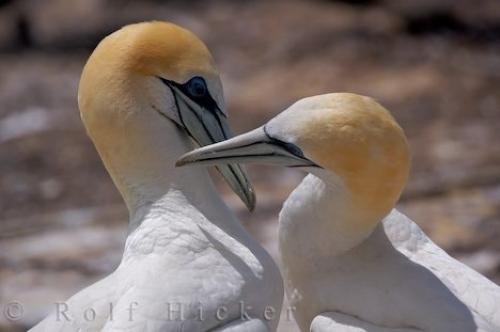Photo: Beautiful Bird Picture Australasian Gannets Hawkes Bay New Zealand
A picture of a pair of beautiful adult Australasian Gannets as they reunite at the Cape Kidnappers bird colony in the Hawke's Bay of New Zealand. Tapping bills is part of their ritualistic greeting.
This intimate picture of a pair of beautiful Australasian Gannets tapping bills at the Cape Kidnappers gannet colony, Hawke's Bay, North Island, New Zealand, illustrates the elegant seabirds' natural greeting ritual. The birds perform this instinctual rite at the nest, stretching their bills and necks skywards and gently tapping bills.
The adult Australasian Gannet (scientific name: Morus serrator) is a magnificently large bird, averaging 2 kg in weight with a wing span of up to 2 metres. Their sleek feathered bodies are mostly white plummage, highlighted with black markings on their wing tips, a pale blue-grey bill and yellow-orange heads.
Young birds are black in their first year, and gradually acquire more white in subsequent seasons until they reach maturity after five years. ... continue below the picture...
Beautiful Bird Picture Australasian Gannets Hawkes Bay New Zealand

Pictures from photo gallery "Adventure Travel"
This picture is part of the photo album "Animal Pictures" - there are more beautiful images waiting for you.
Related stock photo galleries, pictures & travel ideas:
Beautiful Bird Picture Australasian Gannets Hawkes Bay New Zealand
These seabirds are plunge divers and spectacular fishers that eat mainly squid and forage fish which school near the surface. Their fierce bills are designed to pierce fish from as they glide over the water, then pull their wings back and dive at tremendous speeds to capture their food.
The Australasian Gannets are colony breeders. One of the most famous colonies in the world is Cape Kidnappers Gannet Colony on the southern boundary of Hawke's Bay, North Island, New Zealand. It is the largest mainland colony in New Zealand. Here upwards of 15,000 birds live, breed and fish for food.
The tourist season for gannet watching at Hawkes Bay runs from October through April. A variety of tours are available from both the beachfront and overland vantage points. The beautiful birds have a strong, confident personality and are not afraid of humans. They appear very approachable, much to the delight of tourists who want to take pictures. The beautiful birds will often simply stare at tourists with what has been described by many as a look of tolerant contempt.
Australasian Gannet pair, Morus serrator, greeting each other at the Cape Kidnappers colony, Hawke's Bay, North Island, New Zealand.
Technical Information:
I photographed this photo with the digital SLR camera model Canon EOS-1Ds Mark II, aperture of f/8.0, exposure time of 1/1000 sec. on ISO 100, as always I used a original Canon Lens, the focus lenght for this picture was 350mm.
A picture of a pair of beautiful adult Australasian Gannets as they reunite at the Cape Kidnappers bird colony in the Hawke's Bay of New Zealand. Tapping bills is part of their ritualistic greeting.
